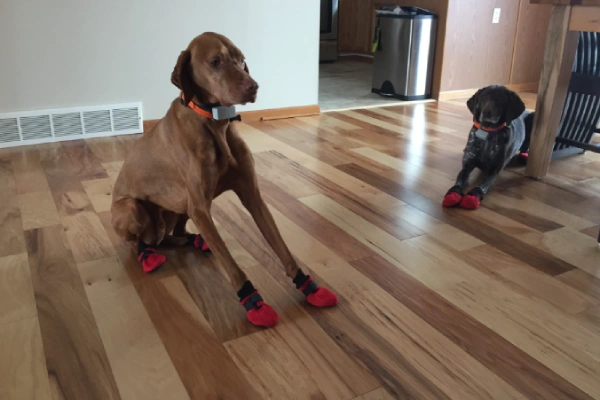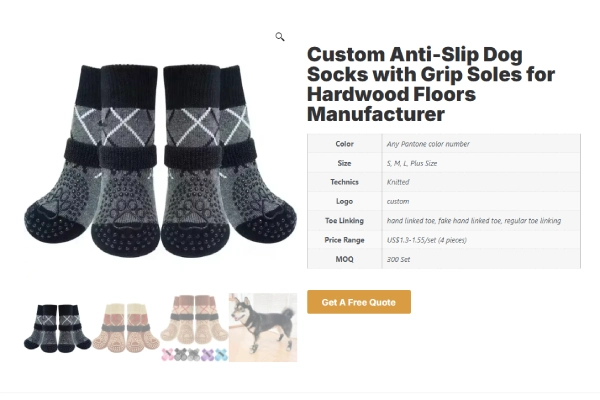Short answer: This guide shows when, where, and how to use dog grip socks to stop slips, protect paws, and run safer daily routines at home and in professional settings. If you need definitions, sizing basics, or market context, see the primer “[What Are Dog Grip Socks?]”. For a deep dive on traction patterns by floor type, use the comparison guide “[Rubber Dots vs. All-Around Coatings vs. Dual-Side Prints]”.
Why this guide

Most questions about non-slip dog socks are practical: where do they work best, how do you make them stay on, and how do you know they’re helping? This article answers those questions with step-by-step routines, selection logic by scenario, and clear KPIs you can track in a week.
Home environments: turning “slippery” into “steady”

Living rooms, corridors, and open plans
- Zone by surface: identify the slick lanes your dog actually uses—entry to water bowl, sofa to door, corridor to stairs. Prioritize those lanes for sock time.
- Session-based wear: put socks on during high-activity windows (morning energy burst, pre-walk zoomies, evening play). Remove for rest to keep paws dry.
- Cornering control: dogs often lose traction at turns. Add a small runner at 90-degree turns; socks plus a runner cut spin-outs dramatically without carpeting the whole home.
Stairs and ramps
- Uphill vs. downhill: most slips occur when going down. Use socks for descents and for the first week after introducing a new ramp.
- Mid-landing check: at split stairs, pause on the landing to re-seat any sock that crept down before taking the final flight.
Apartment living: noise and surface protection
- Socks reduce nail clicks on laminate and help prevent micro-scratches on hardwood. This matters for downstairs neighbors and for tenants who are sensitive to deposits.
Doorway routine that owners actually follow
- At the door: wipe paws, then put on socks (front paws first for control).
- Back home: remove at the mat, check cuffs for dampness, hang to air dry.
- Laundry rhythm: gentle wash, air dry, no fabric softener to preserve grip.
Pattern selection influences performance by floor type; for that decision, jump to the traction comparison guide linked above.
Senior Dogs and Joint Care: From “Can Stand Up” to “Wants to Move”

Aging dogs often lose traction and confidence before they lose strength. The goal is not just helping them stand—it’s helping them want to move again. Dog grip socks give back that security step by step.
Support the Three Key Movements
- Standing up from rest: Non-slip socks stop the paws from sliding outward, allowing the dog to plant firmly and push up in one clean motion instead of several failed attempts.
- Turning and repositioning: Controlled quarter-turns on smooth floors become safe again when the paws grip evenly instead of skating.
- First three strides: Most falls happen in the first seconds after rising. Keep socks on through these early steps to stabilize posture and build confidence.
Create a Safe Micro-Environment
- Socks + mat strategy: Place a mat near the dog’s bed or feeding area for traction during rise and descent. Use socks for the transition zones between those islands of grip.
- Socks vs. paw wax: Wax can help in short, supervised sessions. Socks remain the better option for hours of indoor movement—they protect both the joints and the flooring.
Rebuild Confidence with a 7-Day Tracker
Simple tracking keeps progress visible and prevents frustration:
- Count daily stand-up attempts until success.
- Note any slips or stumbles.
- Check for nail drag marks—a sign of lost traction.
- Record an owner-rated confidence score (1–5) after each walk.
By day seven, a lower number of slips and higher confidence indicate the socks are doing their job. If not, adjust size, fit, or traction pattern and run another week.
Post-surgery and wound care: clean barrier and safe reps

Over-bandage protection
Use a breathable sock as the outer layer to keep dressings clean and reduce licking. Replace the sock when damp. Never trap moisture under the cuff.
Indoor rehab walking, simple SOP
- Phase 1 (Days 1–3 as advised by your vet): 3–5 short laps on the least slick surface in your home. Socks on only during laps.
- Phase 2 (Days 4–7): increase lap count, maintain short duration, add gentle turns.
- Safety checks each session: dry cuffs, intact tread, no rotation past 30°. Stop if you see redness around the band or dewclaw.
“Quick outside” protocol
For brief potty breaks on hot pavement, cold slabs, or damp patios, socks can be a temporary barrier. If surfaces are extreme or time outdoors exceeds a few minutes, switch to true boots.
Special Dogs and Specialized Spaces

Tripod Dogs or Dogs with Mobility Disorders
Dogs missing a limb or dealing with neurological issues need extra stability. Grip socks help them plant their remaining paws firmly and prevent sideways slips. Choose designs with secure straps and anti-rotation cuffs so the tread stays under the paw even as they shift balance. Keep walking sessions short and on straight paths to reduce stress on joints.
Large or Heavy Breeds on Slick Floors
Big dogs generate strong downward and braking force, which increases the chance of sliding on tile or polished wood. Use high-traction, all-around grip socks for maximum hold, and check for wear every few days. Replace early to avoid sudden grip loss that could lead to muscle strain or falls.
Grooming Salons, Veterinary Clinics, and Pet Hotels
In professional spaces, socks are not just cute—they’re safety gear. Staff often use them to prevent dogs from slipping on metal tables, bathtubs, or clinic tiles. A simple rotation system works best:
- Intake: assign a labeled pair to each dog.
- During service: keep socks on during transfers and baths to avoid panic or slipping.
- After use: rinse, disinfect, air dry, and store by size.
This method reduces accidents without altering existing flooring.
Cars, Strollers, and Travel Crates
When dogs enter or exit vehicles or strollers, grip socks stop paws from sliding on smooth ramps or plastic liners. Line the floor with a small non-slip mat and put socks on just for loading and unloading. Remove them for long rides to keep paws dry and comfortable.
Scenario-based selection: a simple three-parameter logic

You do not need to memorize materials science. Match surface × dog weight × wear time and then pick a traction style accordingly in the comparison guide.
- Surface: hardwood and glossy tile demand the most reliable under-paw contact; textured laminate is more forgiving.
- Weight class: <15 lb, 15–50 lb, >50 lb. Heavier dogs need more consistent tread-to-floor contact and faster replacement cycles.
- Wear time: short sessions vs. multi-hour indoor wear. Longer wear favors breathable uppers and rotation with dry pairs.
Need a refresher on sizing or measuring front vs. rear paws? Use the basics and sizing advice in the introduction article linked at the top.
Training and day-to-day care that sticks

First wear, five-minute routine
- Let the dog sniff the pair.
- Put one front sock on, reward, play a short game.
- Add the opposite rear sock, walk 10–15 steps.
- Add the remaining two, do a calm loop.
- Remove, praise, and end. Repeat later the same day.
Rotation and hygiene
- Keep at least two pairs in rotation. Wet socks lose grip and can irritate skin.
- Wash on gentle. Air dry. Skip fabric softener to preserve traction.
- For long coats, trim fur between pads to reduce in-sock slip.
Institutional care
Color-code sizes, label pairs, and store by bin—Disinfect per local guidance without soaking the grip for long periods.
Common mistakes to avoid
- Choosing by pattern alone and ignoring fit and anti-rotation.
- Leaving damp socks on for hours.
- Buying one size for all four paws when the fronts are wider.
- Using socks in place of real boots for rugged, long outdoor use.
FAQs
Do dog grip socks really work on hardwood or tile floors?
Yes. Non-slip dog socks add traction on slick surfaces such as hardwood, tile, or laminate, which helps dogs maintain balance and avoid slips and falls.
Answer: When a dog wears socks with rubberized or silicone grips, the traction between paw and floor improves. That means fewer sideways skids, fewer failed stand-ups, and reduced risk of joint strain from sudden slips. For best results, ensure the sock fits snugly, the grip pattern covers enough area, and the socks remain dry and clean.
How long can I leave dog grip socks on my pet?
You should not leave them on indefinitely without supervision.
Answer: Use socks during periods when traction is needed (e.g., walking across slick floors, during rehab). Remove them after these active periods to let the paws breathe and to check for signs of irritation. Regular breaks help avoid moisture build-up or cuff pressure issues.
What are the main benefits of dog grip socks for senior dogs or post-surgery recovery?
They offer improved stability and protect paws.
Answer: For older dogs with weakened joints or recovery patients, grip socks allow safer movement by reducing slips, helping with stand-ups, and cushioning the paws during transitions. They also act as a clean barrier over bandages or sensitive paw pads, reducing licking or floor contact.
Can regular dog socks work the same as non-slip grip socks?
No — ordinary socks often lack the traction features required for slippery surfaces. alldogboots.com+1
Answer: Regular fabric socks may protect paws or keep them warm, but they lack rubber/silicone tread patterns and secure fastening. Without a grip and a snug fit, they can slip, rotate, or come off — defeating the intended purpose of preventing falls or protecting surfaces.
How should I introduce grip socks so my dog accepts them?
Gradually and positively.
Answer: Let your dog sniff the socks; reward curiosity. Try first one paw, then two, then all four. Use treats and gentle play when socks are on. Keep initial wear sessions short and supervised. This builds positive association and helps your dog adapt to the new footwear.

Dog grip socks are more than pet accessories—they are practical safety tools used across homes, veterinary clinics, grooming salons, and rehabilitation centers. They help dogs maintain traction on slippery floors, protect healing paws, and prevent damage to indoor surfaces. From senior care to post-surgery recovery, their versatility makes them an essential product in the modern pet care supply chain.
For Distributors, Importers, and OEM Partners:
If you’re sourcing high-demand functional pet products, dog grip socks offer proven retail turnover and strong repeat-purchase potential. Max Hosiery provides high-performance full OEM manufacturing, custom branding, and flexible bulk order options for global buyers.
👉 Request a quote or sample kit today to explore how our premium traction sock line can strengthen your catalog and expand your market reach.
